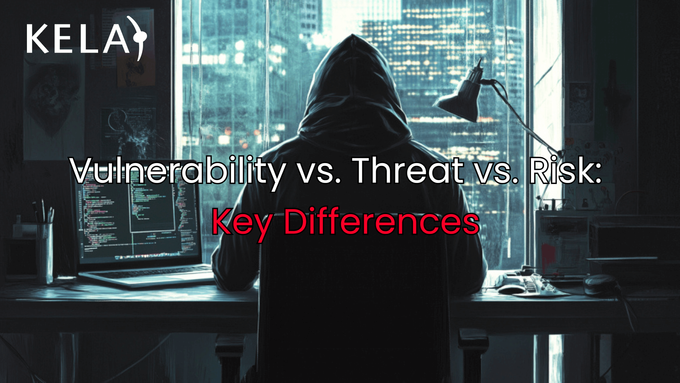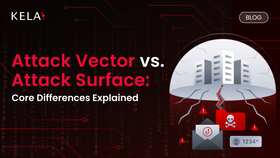Vulnerability vs. Threat vs. Risk: Key Differences
Vulnerability, threat, and risk are closely connected—but understanding how they relate is crucial for making informed security decisions. This guide breaks down the key differences and how to use these terms correctly to strengthen your cybersecurity strategy
Updated April 2, 2025

Understanding the distinctions between vulnerability, threat, and risk is crucial for your cybersecurity efforts. While these terms are often used interchangeably, they represent different yet interconnected aspects of security. In this blog, we’ll break down their key differences and explain how they work together to shape your risk management strategy.
By clarifying these concepts, you can better prioritize your security efforts and allocate resources to mitigate potential threats and vulnerabilities effectively.
» Strengthen your cybersecurity with KELA's expertise
| Feature | Vulnerability | Threat | Risk |
|---|---|---|---|
| Definition | A weakness in a system, process, or human behavior that can be exploited by a threat | A potential danger that can exploit a vulnerability to breach security and cause harm | The potential for loss or damage that arises from a threat exploiting a vulnerability |
| Nature | Static (exists whether or not it's exploited) | Dynamic (can change or evolve) | Consequence of a threat exploiting a vulnerability |
| Examples | Unpatched software, weak passwords, lack of employee training, misconfigured firewall | Malware, phishing attacks, denial-of-service attacks, insider threats, natural disasters | Data breach, financial loss, reputational damage, business disruption, legal liabilities |
| Management | Patching, hardening systems, implementing controls, etc. | Threat intelligence, security awareness training, incident response planning | Risk assessment, risk mitigation strategies, acceptance, or transfer (e.g., insurance) |
| Measurability | Can be quantified (e.g., number of open ports) | Can be assessed (e.g., likelihood and impact) | Can be measured in terms of financial loss, downtime, etc. |
What Is a Vulnerability in Cybersecurity?
A vulnerability is a flaw or weakness in a system, application, or network that can be exploited by threats, such as hackers or malware, to gain unauthorized access or cause damage.
Vulnerability Categories
Software failures: During the development process, bugs may arise that are not identified and corrected, leading to security gaps. Inadequate designs and implementations can introduce flaws that adversaries exploit in attacks such as unauthorized access, privilege escalation, and lateral movement.
Hardware failures: Vulnerabilities in physical components are usually difficult to remediate, requiring physical replacement. Design flaws in processors, firmware bugs, and insecure hardware configurations can create long-term security risks.
Human factors: These can originate from insufficient training, unmapped faulty processes, and a lack of security awareness. Misconfigurations, excessive permissions, or unnecessary services provide entry points for attackers, increasing the risk of data breaches and system compromises.
Vulnerability Management
Vulnerability management focuses on identifying and correcting flaws, prioritizing the most critical ones with the greatest impact on the business.
This process involves continuous monitoring, assessment, and remediation of security weaknesses across software, hardware, and configurations.
Best Practices for Vulnerability Management
- Prioritize assets: Identify and prioritize critical systems, data, and functions to minimize the risk of unknown vulnerabilities affecting key operations.
- Assess risk and exploit likelihood: Evaluate the potential risk and the likelihood of a vulnerability being exploited by analyzing its severity, impact, and exposure to threat actors.
- Conduct scans: Perform regular network and authenticated scans to identify vulnerabilities across systems. Remember to include asset inventory for comprehensive coverage.
- Remediate vulnerabilities: Address identified vulnerabilities through patching and mitigation measures. This includes configuration changes and applying firewall rules.
What Is a Threat in Cybersecurity?
A threat is any actor that can exploit vulnerabilities in a system to cause harm. Threats range in scale and impact from individuals to nations and are shaped by the motivations and techniques of the malicious actors.
3 Different Types of Threats
National threats: Threats such as cyber espionage and cyber warfare are prevalent, with nation-states (APTs) as the main actors. Techniques are sophisticated, including the use of advanced malware and the exploitation of zero-day vulnerabilities.
Organizational threats: Organizations face data theft, ransomware, financial fraud, and cyber espionage with actors such as cybercriminals, hacktivists, and competitors. A variety of techniques can be employed in these attacks, from vulnerability exploitation to DDoS attacks.
Individual threats: Threats such as identity theft and financial fraud are common, with cybercriminals and stalkers as the main actors. Among the commonly employed techniques, phishing and malware are the most popular.
» Understand how threat actors breach and exploit your data
Threat Mitigation
Threat mitigation involves identifying potential threats and vulnerabilities, allowing for the development of countermeasures.
Best Practices for Threat Mitigation
- Identify threats and vulnerabilities: Continuously monitor and analyze systems to identify potential threats and vulnerabilities, understanding attacker behaviors, tactics, capabilities, and motivations.
- Develop countermeasures: Leverage cyber threat intelligence to design and implement effective countermeasures that specifically target identified risks, reducing the chances of successful attacks.
- Implement security measures: Establish and enforce security policies & access controls and conduct regular risk assessments to ensure systems are protected from emerging threats.
Approaches to Threat Mitigation
TTPs Analysis
- Tactics, techniques, and procedures (TTPs) analysis is a qualitative approach that focuses on understanding how cybercriminals operate by analyzing their tactics, techniques, and procedures.
- It provides valuable insights into attacker behavior, helping organizations anticipate and defend against evolving threats.
ATT & CK Platform
- The Adversarial Tactics, Techniques, and Common Knowledge framework (ATT&CK) is a quantitative approach that assigns numerical values to threats using structured metrics, such as risk scores and exploit prediction models.
- It helps organizations measure the likelihood and impact of an attack, allowing them to prioritize mitigation efforts effectively.
» Learn more about threat actors
What Is a Risk in Cybersecurity?
Cyber risk is the potential for harm to befall an organization’s digital assets due to the combination of threats, vulnerabilities, and their impacts. It reflects the likelihood of an attack exploiting a weakness and the severity of the resulting consequences, guiding an organization’s security priorities and response strategies.
External factors that Influence Organizational Risk
- Regulations: Failure to comply with laws and regulations can result in fines and reputational damage, and may also lead to legal consequences that affect business operations.
- Supply chain: Dependence on suppliers increases risk as they can introduce vulnerabilities, potentially compromising the organization’s own security posture and data integrity.
- Geopolitical threats: Geopolitical conflicts can increase cyber risks, as nation-states or state-sponsored actors may target organizations involved in sensitive sectors or international business.
- Cloud infrastructure: Cloud adoption introduces risks such as lack of transparency and provider accountability, which can lead to misconfigurations, data leaks, or service disruptions.
- Open source software (OSS): The use of OSS brings risks such as known vulnerabilities and malicious packages, which may be exploited if not properly vetted and maintained.
- Value chain: Partners can be targets of attacks that affect the organization, especially if they have access to critical systems or sensitive data within the network.
» Here's everything you need to know about infostealers
Risk Management
Risk management can be divided into three categories, namely:
Risk identification: This is the process of recognizing potential threats and vulnerabilities that could negatively impact the organization. It involves identifying internal and external factors that might lead to risks, ensuring that no possible threats are overlooked.
Risk assessment: In this step, the likelihood of a risk occurring is evaluated, along with its potential severity. This includes analyzing vulnerabilities, understanding how they could be exploited, and determining the possible consequences of such exploitation.
Risk response: Once risks have been identified and assessed, organizations must decide how to address them.
Quantifying Risk: Formulas and Models
Risk is commonly quantified using the formula Risk = Threat x Vulnerability x Impact
This formula quantifies risk by combining the probability of a threat event, a vulnerability that can be exploited, and the potential impact of that exploitation.
- Probability refers to the chance that an event will occur
- Impact measures the severity of its consequences
Risk Quantification Models and Tools
Heat Maps
- Heat maps in risk management visually represent the distribution of risk across different areas of an organization.
- By using color-coded scales, they highlight where risks are concentrated, helping teams quickly identify high-risk zones that need immediate attention.
FAIR Model
- The Factor Analysis of Information Risk (FAIR) model breaks down risk into key components, providing a consistent framework for evaluating the financial impact and likelihood of risks.
- It helps organizations assess and prioritize risks based on potential consequences and probability.
Performance Metrics
- Metrics such as coverage and efficiency measure the success of remediation and help adjust efforts to maximize efficiency.
- Coverage measures the completeness of remediation, and efficiency measures the accuracy of remediation.
Roles and Responsibilities in Managing Vulnerabilities, Threats, and Risks
Effective cybersecurity requires collaboration across different functions. Sharing vulnerability and risk data, coordinating patching strategies, and integrating threat intelligence into vulnerability management are crucial for strengthening defenses.
Various teams within an organization work together to protect assets and data, each with specific responsibilities:
- Asset managers: Determine the frequency of scans, categorize data, and monitor assets.
- Blue team: Protect the organization’s assets by defending against and mitigating threats.
- CISO: Define and execute the overall security strategy for the organization.
- DBAs: Ensure database patching and collaborate with developers for secure configurations.
- Developers: Ensure code security, address vulnerabilities during development.
- Infrastructure team: Apply patches and maintain secure system configurations.
- Operations team: Manage operating systems and applications, ensuring system performance.
- Red team: Simulate attacks to find vulnerabilities in systems and processes.
- Security analysts (SOC): Detect, investigate, and remediate threats to protect systems and assets.
- Security engineers: Implement and manage security tools to protect the organization.
- Security project managers: Manage cybersecurity projects and ensure timely completion and risk mitigation.
- Security team: Oversee vulnerabilities, conduct scans, and manage remediation efforts.
- System owners: Oversee remediation efforts to fix identified vulnerabilities within systems.
- Threat intelligence team: Identify, analyze, and share insights on emerging threats and attack methods.
» Understand why you need cyber threat intelligence for your organization
Ongoing Security Improvement
Vulnerability management, threat mitigation, and risk management must be customized to each organization’s unique assets and risks. A balance of proactive actions, like patching, and reactive measures, such as incident response, helps minimize the impact of attacks.
At KELA Cyber, we can help your organization better understand vulnerabilities, threats, and risks through our tailored services, including vulnerability intelligence. Our platform provides contextualized information, empowering you to prioritize vulnerabilities effectively and allocate resources where they are most needed. This approach supports efficient remediation, reduces unnecessary risks, and strengthens your security posture by offering insights into the real-world impact of vulnerabilities.
» Get started for free with KELA and strengthen your cybersecurity





